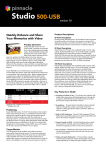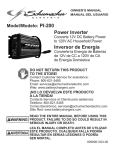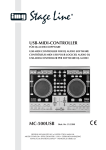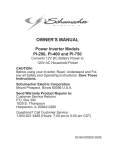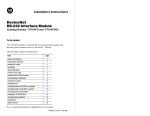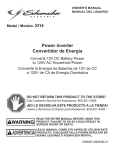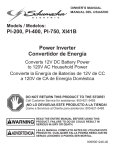Download Schumacher PID-500-USB Owner`s manual
Transcript
OWNER’S MANUAL Power Inverter Models PID-200-USB, PID-500-USB and PID-750 Converts 12V DC Battery Power to 120V AC Household Power CAUTION: Before using your inverter, Read, Understand and Follow all Safety and Operating Instructions. Save These Instructions. Schumacher Electric Corporation Mount Prospect, Illinois 60056 U.S.A. Send Warranty Product Repairs to: Customer Service Returns P.O. Box 280 1025 E. Thompson Hoopeston, IL 60942-0280 Questions? Call Customer Service: 1-800-621-5485 (Hours: 7:00 am to 5:00 pm CST) 00-99-000921-1208 TRADEMARK ACKNOWLEDGEMENTS TRADEMARK ACKNOWLEDGEMENTS Schumacher® is a registered trademark of Schumacher Electric Corporation Schumacher® Logo is a registered trademark of Schumacher Electric Corporation PID-200-USB, PID-500-USB and PID-750 ™ is a trademark of Schumacher Electric Corporation COPYRIGHT INFORMATION PID-200-USB, PID-500-USB and PID-750 Owner’s Manual © 2008 Schumacher Electric Corporation The information, specifications and illustrations in this manual are based on the latest information available at the time of printing. Table of Contents Sectionpage IMPORTANT SAFETY INSTRUCTIONS 5 INVERTER FEATURES 6 BEFORE USING YOUR POWER INVERTER 7 CONNECTING INVERTER CABLES 8 OPERATING INSTRUCTIONS 10 POWER SOURCE 12 HOW DO POWER INVERTERS WORK 13 LED DISPLAY 13 IF THE INVERTER FUSE BLOWS 14 Troubleshooting 15 SPECIFICATIONS 18 REPLACEMENT PARTS 19 LIMITED WARRANTY 20 1. IMPORTANT SAFETY INSTRUCTIONS SAVE THESE INSTRUCTIONS • Keep the inverter well ventilated in order to properly disperse heat generated while it is in use. Make sure there are several inches of clearance around the top and sides and do not block the slots of the inverter. • Make sure the inverter is not close to any potential source of flammable fumes, gases or clothing. • Do not place the inverter in areas such as battery compartments or engine compartments where fumes or gases may accumulate. • Keep the inverter dry. • DO NOT allow the inverter to come into contact with rain or moisture. • DO NOT operate the inverter if you, the inverter, the device being operated or any other surfaces that may come into contact with any power source are wet. Water and many other liquids can conduct electricity, which may lead to serious injury or death. • Do not place the inverter on or near heating vents, radiators or other sources of heat or flammable materials. • Do not place the inverter in direct sunlight. The ideal air temperature for operation is between 50° and 80°F. • Only connect the power inverter to a 12-volt accessory outlet or 12-volt airplane power outlet. Do not attempt to connect the inverter to any other power source, including an AC power source. Connecting to a 6-volt or 16-volt battery will cause damage to the inverter. • Make sure the AC plug and/or USB connection is tight. • 5• • Do not modify the AC or USB receptacle in any way. • Do not try extending or otherwise changing the 12volt power cord attached to your inverter. • Incorrect operation of your inverter may result in damage and personal injury. WARNING: The inverter output is 120V AC and can shock or electrocute the same as any ordinary household AC wall outlet. • Do not open – No user serviceable parts inside. • This device does not include an internal Ground Fault Circuit Interrupter (GFCI). For GFCI protection, use a Coleman Cable 02822 GFCI outlet. • Use only 25-amp fuses (Model PID-200-USB) • Use only 30-amp fuses (Model PID-500-USB). • Use only 45-amp fuses (Model PID-750). WARNING: Pursuant to California Proposition 65, this product contains chemicals known to the State of California to cause cancer and birth defects or other reproductive harm. 2. INVERTER FEATURES 1. ON/OFF Switch 2. Digital Display 3. Two Standard Electrical 120V AC Outlets 4. One, 5V USB Port 5. 12-Volt Power Plug (Models PID-200-USB and PID500-USB) 6. Battery Clamps (Models PID-500-USB and PID750) • 6• 7. High-Speed Cooling Fan 8. Thermal Protection 9. Surge Protection 10. Low-Battery Protection 3. BEFORE USING YOUR POWER INVERTER When you turn on a device or a tool that runs on a motor, the device basically goes through two stages: 1. Start Up – Requiring an initial surge of power (commonly known as the “starting or peak load”). 2. Continuous Operation – Power consumption drops (commonly known as the “continuous load”). The wattage (WATTS) or amperes (AMPS) can normally be found stamped or printed on most devices and equipment, or in the user’s manual. Otherwise, contact the manufacturer to find out whether the device you want to use is compatible with a modified sine wave. To calculate the wattage: Wattage = AMPS x 120 (AC Voltage). To calculate the starting load: Starting Load = 2 x WATTS. In general, the start up load of the device or power tool determines whether your inverter has the capability to power it. To calculate the continuous load: Continuous Load = AMPS x 120 (AC Voltage). Attention: Always run a test to establish whether the inverter will operate a particular piece of equipment or device. In the event of a power overload, the inverter is • 7 • designed to automatically shut down. This safety feature prevents damaging the inverter while testing devices and equipment within the wattage range of the inverter. If a device does not operate properly when first connected to the inverter, turn the inverter rocker switch ON (I), OFF (O), and ON (I) again in quick succession. If this procedure is not successful, it is likely that the inverter does not have the required capacity to operate the device in question. 4. CONNECTING INVERTER CABLES The inverter and power source must be in the OFF mode. IMPORTANT: Make sure you connect your inverter to a 12-volt power supply only. INVERTER CONNECTION (Not necessary for model PID-200-USB): NOTE: For model PID-500-USB, determine whether you will be using the battery clamps (500 watt output maximum) or the 12V accessory plug (120 watts maximum). 1. Locate the positive and negative plastic terminals located on the right side of the inverter and remove the terminal caps completely. 2. Install the positive (red) cable ring lug onto the positive (red) terminal screw. Install the negative (black) cable ring lug onto the negative (black) terminal screw. Tighten each terminal so that the cable cannot come loose. • 8• CONNECTING INVERTER CABLE TO A VEHICLE (Models PID-200-USB and PID-500-USB) (120 watts maximum): 1. Remove the cigarette lighter from its outlet. 2. Push the 12-volt power plug firmly into the outlet. CONNECTING INVERTER CABLES TO 12V BATTERY OR 12V POWER SOURCE (PID-500-USB and PID750): 1. Keep hands, hair, clothing and jewelry clear of battery terminals. 2. Wear eye protection and clothing protection. 3. Connect the negative (black) inverter terminal cable to the power source negative (-) or battery terminal. Make sure the connection is secure. 4. Connect the positive (red) inverter terminal cable to the power source positive (+) or battery terminal. Make sure the connection is secure. 5.To disconnect the inverter, reverse the above steps. NOTE: The internal speaker may make a brief “beep” when the inverter is being connected to or disconnected from the 12-volt power source. ATTENTION: Failure to make the correct connections will result in blown fuses and permanent damage to the inverter. • 9• 5. OPERATING INSTRUCTIONS 1. Connect the inverter (see “CONNECTING INVERTER CABLES” section. 2. Press and hold the ON/OFF switch to turn the inverter on. (The internal speaker will make a brief “beep”. This is normal.). 3. The digital display turns on to the default display of “POWER OUT”. 4. Press and hold the ON/OFF switch to turn the inverter off. 5.Make sure the device to be operated is turned OFF. 6. Plug the device into the inverter AC outlet. 7. Turn the inverter on. The Power Out LED will glow and the digital display will show O. 8. Turn the device on. The display will now show the total wattage used by the device. To change the digital display, press the ON/OFF switch. 9. To disconnect, reverse the above procedure. NOTE: If more than one device is to be powered, start one device at a time to avoid a power surge and overloading the inverter. The surge load of each device should not exceed the inverters Continuous Operation wattage rate. ATTENTION: If there is a short circuit or power surge in the device, will display and the alarm will sound. Press the ON/OFF switch to turn off the alarm. If the displays after several attempts, there is a short circuit or the device requires more “starting” or “peak” load than the inverter is capable of providing. • 10 • IMPORTANT: If you are using the power inverter to operate a battery charger, monitor the temperature of the battery charger for about 10 minutes. If the battery charger becomes abnormally warm, disconnect it from the inverter immediately. NOTE: You can use an extension cord from the inverter to the device without significantly decreasing the power being generated by the inverter. For best operating results, the extension cord should be no longer than 50 feet. Using the Inverter to Operate a TV or Audio Device: The inverter is shielded and filtered to minimize signal interference. Despite this, some interference may occur with your television picture, especially with weak signals. Below are some suggestions to try and improve reception. 1. Make sure the television antenna produces a clear signal under normal operating conditions (i.e. at home plugged into a standard 120-volt AC wall outlet). Also, ensure that the antenna cable is adequately shielded and of good quality. 2. Try altering the position of the inverter, antenna cables, and television power cord. Add an extension cord from the inverter to the TV so as to isolate its power cord and antenna cables from the 12-volt power source. 3. Try coiling the television power cord and the input cables running from the 12-volt power source to the inverter. 4. Affix one or several “Ferrite Data Line Filters” to the television power cord. Ferrite Data Line Filters can be purchased at most electronic supply stores. • 11 • 5. Try grounding the inverter with an 18 AWG (minimum) wire, using as short a length as possible. NOTE: You may hear a “buzzing” sound being emitted from inexpensive sound systems when operated with the inverter. This is due to ineffective filters in the sound system’s power supply. Unfortunately, this problem can only be resolved by purchasing a sound system with a higher quality power supply or higher quality filter. 6. POWER SOURCE Your average automobile or marine battery at full charge will provide an ample power supply to the inverter for approximately 3 hours when the engine is off. The actual length of time the inverter will function depends on the age and condition of the battery and the power demand being placed by the device being operated with the inverter. If you decide to use the inverter while the engine is off, we recommend you turn OFF the device plugged into the inverter and disconnect the inverter’s plug from the 12-volt accessory outlet before starting the engine. To maintain battery power, start the engine every 2 to 3 hours and let it run for approximately 10 minutes to recharge the battery. Although it is not necessary to disconnect the inverter when turning over the engine, it may briefly cease to operate as the battery voltage decreases. While the inverter draws very low amperage when not in use, it should be unplugged to avoid battery drain. • 12 • 7. HOW DO POWER INVERTERS WORK There are two stages involved in transforming 12-volt DC (battery) power into 120-volt AC (household voltage): STAGE 1: The power inverter uses a DC to DC transformer to increase the 12-volt DC input voltage from the power source to 145-volt DC. STAGE 2: The inverter then converts the 145-volt DC into 120-volts AC (household voltage) using advanced MOSFET transistors in a full bridge configuration. A “modified sine wave” waveform is generated by this conversion. 8. LED DISPLAY The LED display identifies the current status of the inverter. VOLTAGE IN: The voltage of the vehicle’s battery, Portable Power jump starter or DC power source. VOLTAGE OUT: The voltage supplied to the device through the AC receptacle. POWER OUT: The power or wattage supplied to the device plugged into the inverter. An audio alarm will sound when any of the following codes display. To stop the alarm, press the ON/OFF switch: – The inverter is not functional. See warranty and call Customer Service 1-800-621-5485 (Hours: 7:00 am to 5:00 pm CST). • 13 • – The vehicle’s battery voltage is more than 15.5-volts. The inverter will automatically restart after the voltage drops below 15.0-volts. – The continuous load demand from the device exceeds the inverter’s wattage output. – The inverter is overheated and automatically turns off for a period of 1 to 3 minutes to cool. Make sure the inverter is well ventilated. It will automatically restart after it cools. – The vehicle’s battery voltage is less than 10.5-volts. – Short circuit, power surge or overload in the device. 9. IF THE INVERTER FUSE BLOWS Your power inverter is fitted with a fuse, which should not have to be replaced under normal operating conditions. A blown fuse is usually caused by reverse polarity or a short circuit within the device or equipment being operated. If the fuse does blow, take the inverter to a qualified technician for repair. • 14 • 10. Troubleshooting PROBLEM Alarm is On REASON Display shows . Device demands too much surge power. or SOLUTION Cycle the inverter power OFF and ON. If problem persists, use a larger inverter or a smaller device. Device has a short circuit Remove the defective device. Display shows . 12volt battery is too low. Recharge/replace battery Display shows voltage in between 10.5 and 11.0-volts. 12-volt battery is low. Recharge or replace battery. The inverter will automatically shut off after battery voltage reaches 10.5-volts. • 15 • PROBLEM REASON SOLUTION Display shows . 12volt voltage is too high. If in a vehicle, repair/ replace the alternator or charging system. Use a properly sized and rated 12-volt battery. If the input voltage returns to 15-volts or less, the inverter will automatically restart. Display shows .Device demands more than the inverter’s continuous power rating. Cycle the inverter power OFF and ON. If problem persists, use a larger inverter or a smaller device. Display shows . Inverter is too hot. • 16 • Increase the ventilation to the inverter. Move the inverter to a cooler area. Reduce the power consumption of the device. The inverter will automatically reset after cooling. PROBLEM REASON SOLUTION Inverter does not turn on. Poor contact at terminals Check for poor connection to battery or power supply. Make sure connection points are clean. Rock clamps back and forth for a better connection. Fuse is blown. A blown fuse is usually caused by reverse polarity or a short circuit within the inverter. To replace, contact a qualified service technician who will diagnose the inverter and replace the fuse(s) with the appropriate replacement(s). Inverter may be defective. See warranty and call Customer Service 1-800-621-5485 (Hours 7:00 am to 5:00 pm CST). • 17 • 11. SPECIFICATIONS Model: PID-200-USB Maximum Continuous Power 200 Watts Surge Capability (Peak Power) 400 Watts No Load Current Draw <0.2A Wave Form Modified Sine Wave Input Voltage Range 10.5V – 15.5V DC Output Voltage Range 120V ± 5% AC Low Battery Alarm Audible, 10.7V – 11.3V DC Low Battery Shutdown 10.5V ± .5V DC High Battery Shutdown 15.0V – 16.0V DC Optimum Efficiency >80% AC Outlet One, 120V AC 3-Prong DC Output One, USB 5V 0.5 Amp Fuse One, 25 Amp Dimensions 6.5” L x 3.75” W x 2” H Weight approximately 1 lb. Model: PID-500-USB Maximum Continuous Power 500 Watts Surge Capability (Peak Power) 1000 Watts No Load Current Draw <0.4A Wave Form Modified Sine Wave Input Voltage Range 10.5V – 15.5V DC Output Voltage Range 120V ± 5% AC Low Battery Alarm Audible, 10.7V – 11.3V DC Low Battery Shutdown 10.5V ± .5V DC High Battery Shutdown 15.0V – 16.0V DC Optimum Efficiency >80% AC Outlet One, 120V AC 3-Prong DC Output One, USB 5V 0.5 Amp Fuse Two, 30 Amp Dimensions 8” L x 5” W x 2.5” H Weight approximately 1.8 lbs. • 18 • Model: PID-750 Maximum Continuous Power 750 Watts Surge Capability (Peak Power) 1500 Watts No Load Current Draw <0.4A Wave Form Modified Sine Wave Input Voltage Range 10.5V – 15.5V DC Output Voltage Range 120V ± 5% AC Low Battery Alarm Audible, 10.7V – 11.3V DC Low Battery Shutdown 10.5V ± .5V DC High Battery Shutdown 15.0V – 16.0V DC Optimum Efficiency >80% AC Outlet Two, 120V AC 3-Prong Fuse Two, 45-Amp Dimensions 9” L x 5” W x 2.5” H Weight approximately 2.6 lbs. 12. REPLACEMENT PARTS Fuses – Replacement fuses can be purchased at most electronic component retailers. Model PID-200-USB None Model PID-500-USB 12V Accessory Plug with Cable Battery Cable with Clamp 38-99-001511 38-99-001512 Model PID-750 Battery Cable with Clamp) 38-99-001534 • 19 • 13. LIMITED WARRANTY SCHUMACHER ELECTRIC CORPORATION, 801 BUSINESS CENTER DRIVE, MOUNT PROSPECT, IL 60056-2179, MAKES THIS LIMITED WARRANTY TO THE ORIGINAL RETAIL PURCHASER OF THIS PRODUCT. THIS LIMITED WARRANTY IS NOT TRANSFERABLE OR ASSIGNABLE. Schumacher Electric Corporation (the “Manufacturer”) warrants this inverter for two years from the date of purchase at retail against defective material or workmanship that may occur under normal use and care. If your unit is not free from defective material or workmanship, Manufacturers obligation under this warranty is solely to repair or replace your product, with a new or reconditioned unit, at the option of the Manufacturer. It is the obligation of the purchaser to forward the unit, along with mailing charges prepaid to the Manufacturer or its authorized representatives in order for repair or replacement to occur. Manufacturer does not provide any warranty for any accessories used with this product that are not manufactured by Schumacher Electric Corporation and approved for use with this product. This Limited Warranty is void if the product is misused, subjected to careless handling, repaired, or modified by anyone other than Manufacturer or if this unit is resold through an unauthorized retailer. Manufacturer makes no other warranties, including, but not limited to, express, implied or statutory warranties, including without limitation, any implied warranty of merchantability or implied warranty of fitness for a particular purpose. Further, Manufacturer shall not be liable for any incidental, special or consequential damage • 20 • claims incurred by purchasers, users or others associated with this product, including, but not limited to, lost profits, revenues, anticipated sales, business opportunities, goodwill, business interruption and any other injury or damage. Any and all such warranties, other than the limited warranty included herein, are hereby expressly disclaimed and excluded. Some states do not allow the exclusion or limitation of incidental or consequential damages or length of implied warranty, so the above limitations or exclusions may not apply to you. This warranty gives you specific legal rights and it is possible you may have other rights which vary from this warranty. THIS LIMITED WARRANTY IS THE ONLY EXPRESS LIMITED WARRANTY AND THE MANUFACTURER NEITHER ASSUMES OR AUTHORIZES ANYONE TO ASSUME OR MAKE ANY OTHER OBLIGATION TOWARDS THE PRODUCT OTHER THAN THIS WARRANTY. Schumacher Electric Corporation Customer Service 1-800-621-5485 Monday – Friday 7:00 a.m. to 5:00 p.m. CST • 21 • MANUAL DEL PROPIETARIO MODELOS DE CONVERTIDOR DE ENERGÍA PID-200-USB, PID-500-USB y PID-750 Convierte la Energía de Baterías de 12V de CD a 120V de CA de Energía Doméstica PRECAUCIÓN: Antes de usar su convertidor, Lea, Entienda y Siga todas las instrucciones De Seguridad y Operación. Guarde Estas Instrucciones. Schumacher Electric Corporation Mount Prospect, Illinois 60056 U.S.A. Envíe las Reparaciones de Garantía del Producto a: Servicio al Cliente Devoluciones P.O. Box 280 1025 E. Thompson Hoopeston, IL 60942-0280 ¿Preguntas? Llame al Servicio de Atención al Cliente: 1-800-621-5485 (Horario: De 7:00 a.m. a 5:00 p.m. CST(Tiempo del Centro)) RECONOCIMIENTOS DE MARCAS DE FÁBRICA RECONOCIMIENTOS DE MARCAS DE FÁBRICA Schumacher® es marca registrada de la Schumacher Electric Corporation Schumacher® Logo es marca registrada de la Schumacher Electric Corporation PID-200-USB, PID-500-USB y PID-750™ es marca de la Schumacher Electric Corporation DATOS DE PROPIEDAD INTELECTUAL PID-200-USB, PID-500-USB y PID-750 Owner’s Manual © 2008 Schumacher Electric Corporation La información, las especificaciones y las ilustraciones en el presente manual se basan en la información más al día disponible a la hora de imprimir. table of contents SECCIÓN PÀGINA INSTRUCCIONES IMPORTANTES DE SEGURIDAD 27 CARACTERÍSTICAS DEL CONVERTIDOR 29 ANTES DE USAR SU CONVERTIDOR DE ENERGÍA 29 PARA CONECTAR LOS CABLES DEL CONVERTIDOR 31 INSTRUCCIONES DE OPERACIÓN 32 FUENTE DE ENERGÍA 35 CÓMO FUNCIONAN LOS CONVERTIDORES DE CORRIENTE 36 VISUALIZADOR LED 37 SI SE QUEMA EL FUSIBLE DEL CONVERTIDOR 38 RESOLUCIÓN DE PROBLEMAS 39 ESPECIFICACIONES 42 PIEZAS DE REPUESTO 43 GARANTÍA LIMITADA 43 1. INSTRUCCIONES IMPORTANTES DE SEGURIDAD GUARDE ESTAS INSTRUCCIONES • Mantenga el convertidor bien ventilado para dispersar apropiadamente el calor generado cuando está en uso. Asegúrese de que haya varias pulgadas de libramiento alrededor de la parte superior y lados y no bloquee las ranuras del convertidor. • Asegúrese de que el convertidor no esté cerca de ninguna fuente potencial de gases inflamables, gases o ropa. • No coloque el convertidor en áreas tales como compartimientos de baterías o compartimientos del motor donde los vapores o gases pueden acumularse. • Mantenga el convertidor seco. • NO OPERE el convertidor si usted, el convertidor, el dispositivo a ser operado o cualquier otra superficie puede entrar en contacto con cualquier fuente de energía que está húmeda. El agua y muchos otros líquidos pueden conducir electricidad, lo cual puede llevar a una lesión seria o la muerte. • NO OPERE el convertidor si usted, el convertidor, el dispositivo a ser operado o cualquier otra superficie que puede entrar en contacto con cualquier fuente de energía está húmeda. El agua y muchos otros líquidos pueden conducir electricidad, lo cual puede llevar a una lesión seria o la muerte. • No coloque el convertidor sobre o cerca de ventilas de calefacción, radiadores u otras fuertes de calor o materiales inflamables. • No coloque el convertidor en la luz directa del sol. La temperatura del aire ideal para la operación es entre 50° y 80°F. • 27 • • Solamente conecte el convertidor de energía a una toma de corriente accesoria de 12 V o a una toma de energía de 12 V en un avión. No intente conectar el convertidor a cualquier otra fuente de energía, incluyendo una fuente de energía de CA (corriente alterna). El conectarlo a una batería de 6 V o 16 V dañará el convertidor. • Asegúrese de que la clavija de CA y/o la conexión USB estén ajustadas. • No modifique la toma de CA o USB de ninguna manera. • No trate de extender o cambiar de forma alguna el cable de corriente de 12 V sujeto a su convertidor. • La operación incorrecta de su convertidor puede resultar en daño y lesión personal. ADVERTENCIA: La salida del convertidor es de 120 V CA y puede dar una descarga o electrocutar igual que cualquier toma de corriente de pared doméstica de CA ordinaria. • No abrir - No contiene partes que el usuario pueda reparar. • Este dispositivo no incluye un Interruptor de Circuito con Conexión a Tierra (GFCI por sus siglas en inglés) interno. Para protección de GFCI, use un Cable Coleman 02822 toma de corriente GFCI. • Usa solamente fusibles de 25 amp (Modelo PID-200USB) • Usa solamente fusibles de 30 amp (Modelo PID-500USB). • Use solamente fusibles de 15 amp (Modelo PID750). • 28 • ADVERTENCIA: De acuerdo a la Proposición 65 de California, este producto contiene químicos conocidos al Estado de California como causantes de cáncer y defectos congénitos u otros daños reproductivos. 2. CARACTERÍSTICAS DEL CONVERTIDOR 1. Interruptor de ENCENDIDO/APAGADO (ON/OFF) 2. Visualizador Digital 3. Dos Tomas de Corriente Eléctrica Estándar de 120 V de CA 4. Un Puerto USB de 5V 5. Clavija de 12 V Energía (Modelos PID-200-USB y PID-500-USB) 6. Abrazaderas de Batería (Modelos PID-500-USB y PID-750) 7. Abanico Criador de Alta Velocidad 8. Protección Térmica 9. Protección Contra Sobretensiones 10. Protección Contra Batería Baja 3. ANTES DE USAR SU CONVERTIDOR DE ENERGÍA Cuando usted enciende un dispositivo o una herramienta que funciona con un motor, el dispositivo básicamente pasa a través de dos etapas: • 29 • 1. Arranque - Requiriendo una subida inicial de voltaje (comúnmente conocida como "carga de inicio o pico"). 2. Operación Continua - el consumo de energía desciende (comúnmente conocido como la "carga continua"). El vataje (WATTS) o amperaje (AMPS) pueden ser encontrados normalmente estampados o impresos en la mayoría de los dispositivos y equipo, o en el manual del usuario. Por lo demás, comuníquese con el fabricante para averiguar si el dispositivo que usted quiere usar es compatible con una onda senoidal modificada. Para calcular el vataje: Vataje = AMPS x 120 (Voltaje CA). Para calcular la carga de arranque: Carga de Arranque = 2 x WATTS. En general, la carga de arranque del dispositivo o herramienta eléctrica determina si su convertidor tiene la capacidad de hacerlo funcionar. Para calcular la carga continua: Carga Continua = AMPS x 120 (Voltaje CA). Atención: Siempre corra una prueba para establecer si el convertidor operará una pieza particular de equipo o dispositivo. En caso de una sobrecarga de corriente, el convertidor está diseñado para apagarse automáticamente. Ésa característica de seguridad evitar dañar el convertidor mientras se prueban dispositivos y equipo dentro del ámbito de vataje del convertidor. Si un dispositivo no funciona apropiadamente cuando se conecta por primera vez al convertidor, de vuelta al interruptor broker a ENCENDIDO (ON) (I), APAGADO (OFF) • 30 • (O) y nuevamente ENCENDIDO (ON) (I) en rápida sucesión. Si este procedimiento no tiene éxito, es probable que el convertidor no tenga la capacidad requerida para operar el dispositivo en cuestión. 4. PARA CONECTAR LOS CABLES DEL CONVERTIDOR El convertidor y la fuente de energía deben estar en el modo APAGADO (OFF). IMPORTANTE: Asegúrese de conectar su convertidor a una fuente de energía de 12 V solamente. CONEXIÓN DEL CONVERTIDOR (No es necessito para modelo PID-200-USB): NOTA: Para el modelo pi eso-400, determine si usara las abrazaderas de la batería (salida máxima de 400 watts) o la clavija accesoria de 12 V (máximo 120 watts). 1. Ubique las terminales plásticas positiva y negativa localizadas en el lado derecho del convertidor y quite completamente las tapas de las terminales. 2. Instale el anillo del cable positivo (rojo) en el tornillo de la terminal positiva (roja). Instale el anillo del cable positivo (negro) en el tornillo de la terminal positiva (negra). Apriete cada terminal para que el cable no pueda soltarse. PARA CONECTAR EL CABLE DEL CONVERTIDOR A UN VEHÍCULO (Modelos PID-200-USB y PID-500USB): 1. Quite el encendedor de cigarrillos de su toma de corriente. • 31 • 2. Empuje la clavija de 12 V firmemente en la toma de corriente. PARA CONECTAR LOS CABLES DEL CONVERTIDOR A UNA BATERÍA DE 12 V O UNA FUENTE DE ENERGÍA DE 12 V (PID-500-USB y PID-750): 1. Mantenga las manos, cabello, ropa y joyería alejados de las terminales de la batería. 2. Usé protección para ojos y protección para la ropa. 3. Conecte el cable de la terminal negativa (negro) del convertidor a la fuente de energía negativa (-) o terminal de la batería. Asegúrese de que la conexión sea segura. 4. Conecte el cable de la terminal positiva (rojo) del convertidor a la fuente de energía positiva (+) o terminal de la batería. Asegúrese de que la conexión sea segura. 5. Para desconectar el convertidor, invierta los pasos anteriores. NOTA: La bocina interna puede hacer breve “bip” cuando el convertidor está siendo conectado a o desconectado de la fuente de energía de 12 V. ATENCIÓN: El no hacer las conexiones correctas resultará en fusibles quemados y daño permanente el convertidor. 5. INSTRUCCIONES DE OPERACIÓN 1. Conecte el convertidor (ver la sección “PARA CONECTAR LOS CABLES DEL CONVERTIDOR”). • 32 • 2. Oprima y mantenga oprimido el interruptor ENCENDIDO/APAGADO (ON/OFF) para encender el convertidor. (La bocina interna un breve “bip”. Esto es normal.). 3. El visualizador digital se enciende con la demostración por defecto de “SALIDA DE ENERGÍA”. 4. Oprima y mantenga oprimido el interruptor ENCENDIDO/APAGADO (ON/OFF) para apagar el convertidor. 5. Asegúrese de que el dispositivo a ser operado este APAGADO (OFF). 6. Conecte el dispositivo en la toma de corriente CA del convertidor. 7. Encienda el dispositivo. El LED de Salida de Energía brillará y el visualizador digital mostrará O. 8. Enciende el dispositivo. El visualizador mostrará ahora el vataje total usado por el dispositivo. Para cambiar el visualizador digital, presione el interruptor ENCENDIDO/APAGADO (ON/OFF). 9. Para desconectar, invierta el procedimiento anterior. NOTA: Si se va a dar energía a más de un dispositivo, inicie un dispositivo a la vez para evitar una sobretensión de energía y sobrecargar el convertidor. La sobretensión de cada dispositivo no debe exceder el ámbito de vataje de Operación Continúa el convertidor. ATENCIÓN: Si hay un corto circuito o sobretensión en el dispositivo, se mostrará en el visualizador y sonara la alarma. Oprima y mantenga oprimido el interruptor • 33 • ENCENDIDO/APAGADO (ON/OFF) para apagar el convertidor. Si él se muestra después de varios intentos, hay un cortocircuito o el dispositivo requiere más carga de “arranque” o “pico” de lo que el convertidor puede proporcionar. IMPORTANTE: Si usted usando el convertidor de energía para operar un cargador de baterías, monitoree la temperatura del cargador de baterías por aproximadamente 10 minutos. Si el cargado de graderías se pone anormalmente caliente, desconéctelo del convertidor inmediatamente. NOTA: Usted puede escuchar un sonido de “zumbido” siendo emitido de sistemas de sonido baratos cuando son operados con el convertidor. Esto es debido a filtros inefectivos en el abastecimiento de energía del sistema de sonido. Lamentablemente, este problema solamente puede ser resuelto comprando un sistema de sonido con una calidad más alta de abastecimiento de sonido o un filtro de más alta calidad. Para Usar El Convertidor Para Operar Una Televisión O Dispositivo De Sonido: El convertidor está protegido y filtrado para minimizar la interferencia con la señal. A pesar de esto, alguna interferencia puede ocurrir con la imagen de su televisión, especialmente con señales débiles. Abajo y algunas sugerencias para tratar y mejorar la recepción. 1. Asegúrese de que la antena de televisión produzca una señal clara bajo condiciones normales de operación (Ej. en casa conectado en una toma de corriente de pared estándar de 120 V de CA). También, asegúrese de que el cable de la antena este protegido adecuadamente y que sea de buena calidad. • 34 • 2. Trate de alterar la posición del convertidor, los cables de la antena y el cable de corriente de la televisión. Agregue un cable de extensión del convertidor a la televisión para aislar el cable de energía y los cables de la antena de la fuente de energía de 12 V. 3. Intente enrollar el cable de energía de la televisión y los cables de aporte que van de la fuente de energía de 12 V al convertidor. 4. Fije uno o varios “Filtros de Línea de Datos de Ferrita” al cable de energía de la televisión. Los Filtros de Línea de Datos de Ferrita pueden comprarse la mayor parte de las tiendas de partes electrónicas. 5. Intente conectar a tierra el convertidor con un alambre de 18 AWG (medida de cable americana) (mínimo), usando un tramo tan corto como sea posible. NOTA: Usted puede escuchar un sonido de “zumbido” siendo emitido de sistemas de sonido baratos cuando son operados con el convertidor. Esto es debido a filtros inefectivos en el abastecimiento de energía del sistema de sonido. Lamentablemente, este problema solamente puede ser resuelto comprando un sistema de sonido con una calidad más alta de abastecimiento de sonido o un filtro de más alta calidad. 6. FUENTE DE ENERGÍA Su batería de automóvil o marina promedio a toda carga proporcionará un abastecimiento de energía amplio para él convertidor por aproximadamente dos a tres horas cuando el motor está apagado. El tiempo total que el convertidor funcionará depende de la edad y condición • 35 • de la batería y de la demanda de energía colocada por el dispositivo siendo operado con el convertidor. Si decide usar el convertidor mientras el motor está apagado, le recomendamos que apague el dispositivo conectado al convertidor antes de arrancar el motor. Para mantener la energía de la batería, arranque el motor cada hora o dos y déjelo encendido por aproximadamente 10 minutos para recargar la batería. Aunque no es necesario desconectar el convertidor cuando arranca de nuevo el motor, puede dejar de operar brevemente mientras disminuye el voltaje de la batería. Aunque el convertidor extrae muy poco amperaje cuando no está en uso, debe ser desconectado para evitar descargar la batería. 7. CÓMO FUNCIONAN LOS CONVERTIDORES DE CORRIENTE Hay dos etapas involucradas en la transformación de la energía de 12 V de CD (batería) a 120 V de CA (voltaje doméstico): ETAPA 1: El convertidor de corriente usa un transformador de CD a CD para aumentar la aportación de voltaje de 12 V de CD de la fuente de energía a 145 V de CD. ETAPA 2: El convertidor entonces convierte los 145 V de CD a 120 V de CA (voltaje doméstico) usando avanzados transistores MOSFET en una configuración de puente completo. Una “onda senoidal modificada” se genera por esta conversión. • 36 • 8. VISUALIZADOR LED El visualizador LED identifica el estado actual del convertidor. VOLTAJE DE ENTRADA: El voltaje de la batería del vehículo, el arrancador de Energía Portátil, o la fuente de energía CD. VOLTAJE DE SALIDA: El voltaje proporcionado al dispositivo a través del receptáculo de CA. SALIDA DE ENERGÍA: La energía o vataje proporcionados al dispositivo conectado al convertidor. Una alarma auditiva sonará cuando cualquiera de los siguientes códigos se muestre. Para detenerla la alarma, presione el interruptor ENCENDIDO/APAGADO (ON/ OFF). – El convertidor no es funcional. Vea la Garantía y llame al Servicio al Cliente al 1-800-621-5485 (Horario: De 7:00 a.m. a 5:00 p.m. CST (Tiempo del Centro)) – El voltaje de la batería del vehículo es más de 15.5V. El convertidor automáticamente reiniciará después de que el voltaje caiga por debajo de los 15.0 V. – La demanda de carga continúa del dispositivo excede el vataje de salida del convertidor. – El convertidor se sobrecalentó y se apaga automáticamente por un período de uno a tres minutos para enfriarse. Asegúrese de que el convertidor esté bien ventilado. Reiniciará automáticamente cuando se enfríe. • 37 • – El voltaje de la batería del vehículo es menor de 10.5V. – Cortocircuito, sobretensión o sobrecarga en el dispositivo. 9. SI SE QUEMA EL FUSIBLE DEL CONVERTIDOR Su convertidor de corriente está equipado con un fusible, que no tendría que ser reemplazado bajo condiciones normales de operación. Un fusible quemado es causado usualmente por una polaridad inversa como un cortocircuito dentro del dispositivo o equipo siendo operados. Si el fusible se quema, lleve el convertidor a un técnico calificado para reparaciones. • 38 • 10. RESOLUCIÓN DE PROBLEMAS PROBLEMA RAZÓN SOLUCIÓN La Alarma Está Encendida El visualizador muestra . El dispositivo demanda demasiada energía de sobretensión. Cicle la energía del convertidor APAGADO (OFF) y ENCENDIDO (ON). Si el problema persiste, use un convertidor más grande o un dispositivo más chico. o El dispositivo tiene un cortocircuito Quite el dispositivo defectuoso. El visualizador muestra . La batería de 12 V está demasiado baja. Recargue/reemplace la batería. El visualizador muestra el voltaje entre 10.5 y 11.0V. La batería de 12 V está baja. Recargue o reemplace la batería. El convertidor se apagará automáticamente después de que el voltaje de la batería llegue a los 10.5V. • 39 • PROBLEMA La Alarma Está Encendida RAZÓN SOLUCIÓN El visualizador muestra . El voltaje de 12 V está demasiado alto. Si está en un vehículo, repare/reemplace el alternador o sistema de carga. Use una batería de 12 V del tamaño y clasificación apropiados. Si el voltaje de entrada vuelve a 15 V o menos, el convertidor reiniciará automáticamente. El visualizador muestra . El dispositivo demanda más que la clasificación de energía continua del convertidor. Cicle la energía del convertidor APAGADO (OFF) y ENCENDIDO (ON). Si el problema persiste, use un convertidor más grande o un dispositivo más chico. El visualizador muestra . El convertidor está demasiado caliente. Aumente la ventilación al convertidor. Mueva el convertidor a un área más fresca. Reduzca el consumo de energía del dispositivo El convertidor se restablecerá automáticamente después de enfriarse. • 40 • PROBLEMA El convertidor no enciende. RAZÓN SOLUCIÓN Mal contacto en las terminales. Revise por una mala conexión a la batería o abastecimiento de energía. Asegúrese de que los puntos a conexión estén limpios. Balancee las abrazaderas hacia adelante hacia atrás para una mejor conexión. El fusible está quemado. Un fusible quemado es causado usualmente por una polaridad inversa o un cortocircuito dentro del convertidor. Para reemplazar, comuníquese con un técnico de servicio calificado que diagnosticará el convertidor y reemplazará el/ los fusible/s con él/los reemplazo/s apropiado/s. El convertidor puede estar defectuoso. Vea la Garantía y llame al Servicio al Cliente al 1-800-621-5485 (Horario: De 7:00 a.m. a 5:00 p.m. CST (Hora del Centro)). • 41 • 11. ESPECIFICACIONES Modelo: PID-200-USB Máxima Energía Continua 200 Watts Capacidad de Tensión (Potencia Máxima) 400 Watts Consumo de Corriente en Vacío <0.2A Forma de Onda Onda Senoidal Modificada Ámbito de Tensión de Entrada 10.5V a 15.5V DC Ámbito de Tensión de Salida 120V ± 5% AC Alarma de Batería Baja Audible, 10.7V a 11.3V CD Cierre por Batería Baja 10.5V ± .5V DC Cierre por Batería Alta 15.0V a 16.0V DC Óptima Eficiencia >80% Toma de Corriente CA Una, 120 V CA 3 Punta Toma de Corriente CD Una, USB 5 V 0.5 Amp Fusible Un, 25 amps Dimensiones 6.5” L x 3.57” A x 2” P Peso Aproximadamente 1 libra Modelo: PID-500-USB Máxima Energía Continua 500 Watts Capacidad de Tensión (Potencia Máxima) 1000 Watts Consumo de Corriente en Vacío <0.4A Forma de Onda Onda Senoidal Modificada Ámbito de Tensión de Entrada 10.5V a 15.5V DC Ámbito de Tensión de Salida 120V ± 5% AC Alarma de Batería Baja Audible, 10.7V a 11.3V CD Cierre por Batería Baja 10.5V ± .5V DC Cierre por Batería Alta 15.0V a 16.0V DC Óptima Eficiencia >80% Toma de Corriente CA Dos, 120 V CA 3 Puntas Toma de Corriente CD Una, USB 5 V 0.5 Amp Fusible Dos, 30 amps Dimensiones 8” L x 5” A x 2.5” P Peso Aproximadamente 1.8 libras • 42 • Modelo: : PID-750 Máxima Energía Continua 750 Watts Capacidad de Tensión (Potencia Máxima) 1500 Watts Consumo de Corriente en Vacío <0,4A Forma de Onda Onda Senoidal Modificada Ámbito de Tensión de Entrada 10.5V a 15.5V DC Ámbito de Tensión de Salida 120V ± 5% AC Alarma de Batería Baja Audible, 10.7V a 11.3V CD Cierre por Batería Baja 10.5V ± .5V DC Cierre por Batería Alta 15.0V a 16.0V DC Óptima Eficiencia >80% Toma de Corriente CA Dos, 120 V CA 3 Puntas Fusible Dos, 45 amps Dimensiones 9” L x 5” A x 2.5” P Peso Aproximadamente 2.6 libras 12. PIEZAS DE REPUESTO Modelo PID-200-USB Nada Modelo PID-500-USB Clavija Accesoria de 12 V con Cables 38-99-001511 Cable de Batería con Abrazaderas 38-99-001512 Modelo PID-750 Cable de Batería con Abrazaderas 38-99-001534 13. GARANTÍA LIMITADA SCHUMACHER ELECTRIC CORPORATION, 801 BUSINESS CENTER DRIVE, MOUNT PROSPECT, IL 60056-2179, DA ESTA GARANTÍA LIMITADA AL COMPRADOR ORIGINAL AL MENUDEO DE ESTE PRODUCTO. ESTA GARANTÍA LIMITADA NO ES TRANSFERIBLE O ASIGNABLE. • 43 • Schumacher Electric Corporation (el “Fabricante”) garantiza este convertidor por dos años a partir de la fecha de compra al menudeo contra material defectuoso o trabajo de fabricación que pueda ocurrir bajo el uso y cuidado normal. Si su unidad no está libre de material o trabajo de fabricación defectuoso, la obligación del Fabricante bajo esta garantía es únicamente reparar o reemplazar su producto, con uno a unidad nueva o reacondicionada, a opción del Fabricante. Es obligación del comprador enviar la unidad, junto con costos de envío por correo pre-pagados al Fabricante o sus representantes autorizados para qué la reparación o reemplazo ocurran. El Fabricante no proporciona ninguna garantía para ningún accesorio usado con este producto que no esté fabricado por Schumacher Electric Corporation y aprobado para uso con este producto. Esta Garantía Limitada es nula si el producto se emplea mal, se sujeta a manejo descuidado, se repara o modifica por alguien que no sea él Fabricante o si esta unidad se vuelve a vender a través de un vendedor no autorizado. El Fabricante no da ninguna otra garantía, incluyendo, pero sin limitarse a, garantías expresas, implicadas o creadas por la ley, incluyendo sin limitación, cualquier garantía implicada de comercialización o garantía implicada de aptitud para un propósito particular. Además, el Fabricante no será responsable por cualesquier demandas por daño incidental, especial o de consecuencia en que incurran los compradores, usuarios u otros asociados con este producto, incluyendo, pero sin limitarse a ganancias, ingresos, ventas anticipadas, oportunidades de negocios, buena voluntad, interrupción de negocios perdidos y cualquier otra lesión o daño. Cualquier las garantías, que no sean las de la garantía limitada • 44 • incluidas en el este, están por el presente expresamente denegadas y excluidas. Algunos estados no permiten la exclusión o limitación de daños incidentales o de consecuencia o el largo de la garantía implícita, así que las limitaciones o exclusiones anteriores pueden no ser aplicables para usted. Esta garantía le da derechos legales específicos y es posible que pueda tener otros derechos que varían de esta garantía. ESTA GARANTÍA LIMITADA ES LA ÚNICA GARANTÍA LIMITADA EXPRESA Y EL FABRICANTE NO ASUME NI AUTORIZA A NADIE A ASUMIR O OFRECER NINGUNA OTRA OBLIGACIÓN HACIA EL PRODUCTO QUE NO SEA ESTA GARANTÍA. Servicio al Cliente de Schumacher Electric Corporation 1-800-621-5485 De Lunes a Viernes de las 7:00 a.m. 5:00 p.m. CST • 45 •
















































